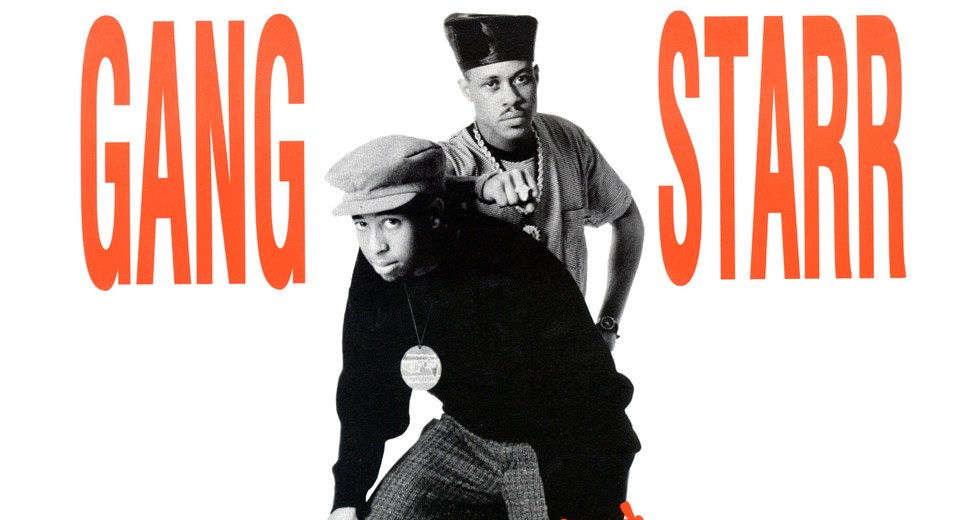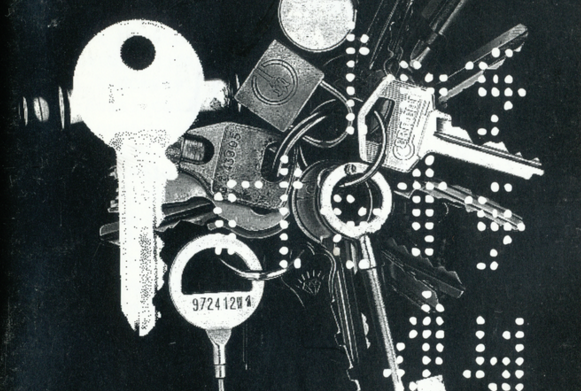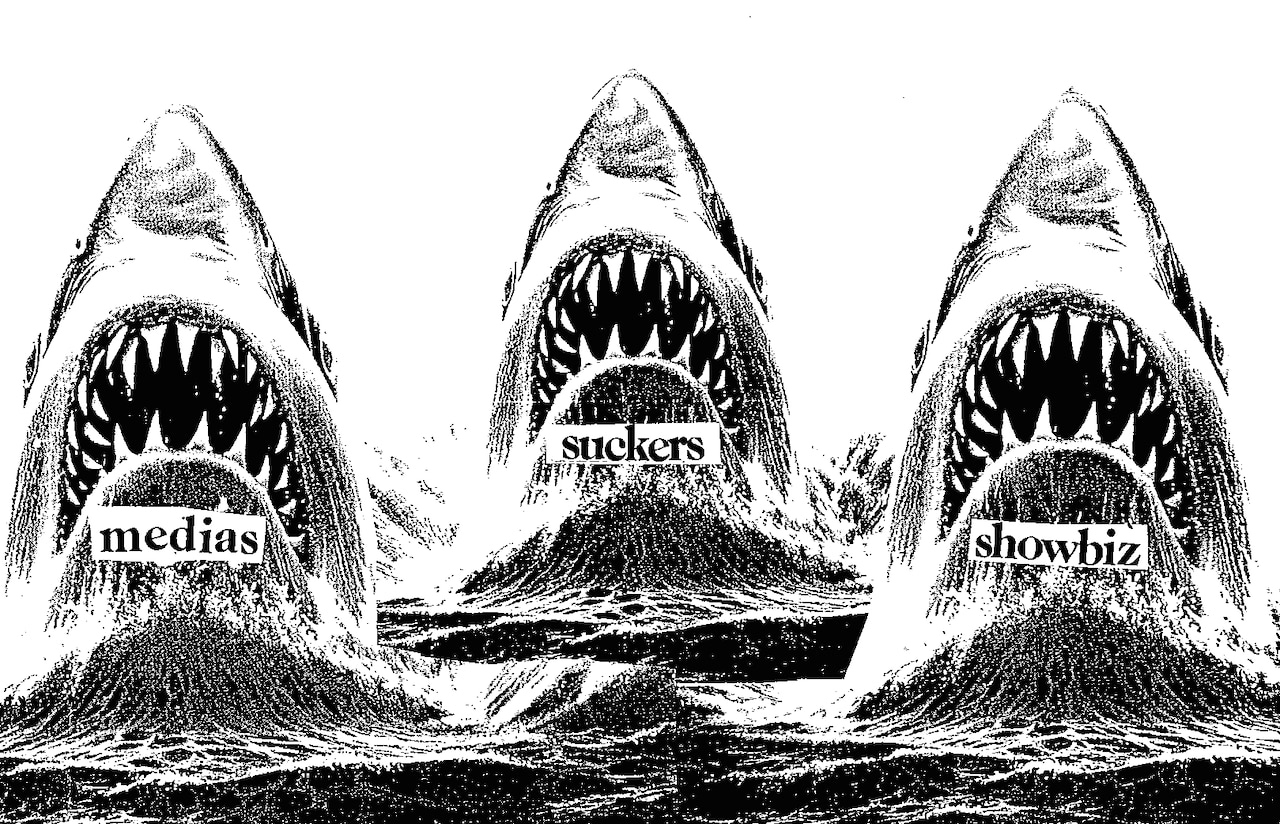
Get Busy: No Suckers Allowed!
Even if Mme Hervé, his French teacher, did in fact tell him that one day, he’d make an excellent journalist, Stéphane Bégoc, AKA SEAR, never thought of writing as a calling, or even as part of his career plan. It was simply an obligation. He had to recount the early days of the hip hop movement he was witnessing from inside the scene in his hometown of Saint Denis – a movement he failed to recognize in the media coverage of the time.
As a reaction to this, Get Busy saw the day principally fuelled by an ideal, that of an impassioned musical press that was independent, one that didn’t believe in compromise. Very quickly, the style of the fanzine gave SEAR an exceptional vantage point within the rap press whereas so many others engaged in dubious commercial practices. Their aim was a total freedom of approach, including the punchlines: deadly blows that the writers delivered without kid gloves, though they never hit below the belt. It was all simply for the love of a light roasting, or a “chambrette” in the words of Sear himself, a regional sport for those who grew up in the Badlands to the north of Paris.
From its beginnings on the photocopier to the glossy paper and color photos of the editions sold in newsagents, Get Busy went through several metamorphoses throughout the ’90s, with radical changes in format and staff. At its helm, SEAR was a constant figure, just like his tracksuit n’ Fila trademark style. As he is currently putting the final touches on a new issue due out in May 2016, this Signataire Eternel d’Articles Radicaux (SEAR or “Eternal Signatory of Radical Articles”) revisits the story of his fanzine, cover after cover.
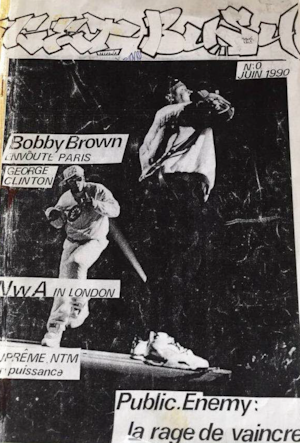
Get Busy Fanzine #0
At the end of the ’80s, rap was a musical force that turned the world on its axis. As Public Enemy were releasing their debut album, France was witnessing the birth of local powerhouses like NTM, Assassin and IAM. This was a time when guitar music was stalling. So the music press leapt on the bandwagon.
A shitload of dumbass articles started to appear, full of mistakes, stereotypes and cliché. Everything always had to hark back to rock & roll: Public Enemy were the new Clash, LL Cool J was the Elvis of rap and so on. At Rock&Folk, there was this journalist, Phil Ox, who would review rap records just for the pleasure of dragging them through the mud. At the same time, [regional paper] le Parisien published a map of the gangs which were supposedly rife in Parisian banlieues, and people like NTM or Litlle MC were in it. At a Public Enemy concert at the Zenith, [TV presenter] Guillaume Durand even had this embedded envoy who reported back live every ten minutes to inform us of the race wars that were about to break out...
At this point, we’d had enough. It was time for a hip hop fanzine created by people who were actually part of all that. So with this idea, as obvious as it was naive, we launched Get Busy.

Get Busy Fanzine #1
Though the fanzine was born as a reaction to the way rap was treated in the media at the time, Get Busy was also the product of constant one-upmanship, something common to all hip hop scenes. I can’t help but think of IZB, a crew that was essential to the evolution of French hip hop that I used to hang with all the time.
Crazy Jm was their top guy, and he had this incredible energy, so he managed to reach all these different people – from posers to the biggest thugs ever – he got them all to set things in motion, whether we’re talking parties, concerts or fanzines, funnily enough. So Get Busy saw the day, as we were part of all that.
We did it all through trial and error, through sheer nerve and just by getting on with it. The first issue contained little more than eight pages. We must have created about 100 of them, using these black and white photocopies we did in Montparnasse which were then stapled together in a Free Time, a fast food joint near Les Halles. Then we went and handed out the fanzine at the Bobino club where they had these Zoopsy nights.
We got a warm welcome, and very quickly, we met quite a few people who helped us improve. David Dufresne, who was preparing a book on rap, helped us a lot when it came to layout. Angelo, Crazy Jm’s brother, was starting to get these contacts within major labels, so he got us advertising. And IZB started organising huge concerts. So we managed to clinch interviews with the stars of the time: Gang Starr, Ice Cube, Public Enemy and more.
As time wore on, our content became richer and richer and its format more “lush”: the final issue of the fanzine version was already on glossy paper, with a colour photo... but we never made any proper money from Get Busy.
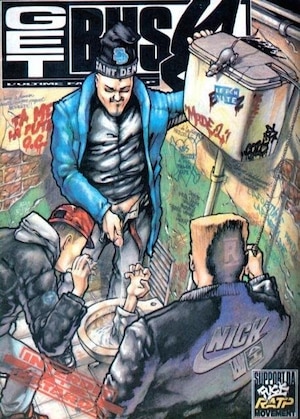
Get Busy Fanzine #5
This cover is straight from COLT’s imagination and features the skills of Mode 2 – two of the best graffiti artists to have ever seen the day in France. They liked Get Busy. At the time, we all knew NTM in some way, all the connections passed through them. Colt drew logos for Get Busy, for Assassin, for NTM, and for more besides. He was really gifted. Mode 2 was just as good. And I think this is one of the most striking things they’ve ever done.
The cover shows the tree of us – Reso and Texaco and yours truly, all members of Get Busy, in this graffiti covered crapper. I’m pissing in the bowl – and yes, you can see, in passing, that I do have a big dick – and an arm is coming out of the toilet, that’s a “sucker” getting drowned... They also used the graffiti on the walls to settle certain scores. Everyone was talking about it at the time.
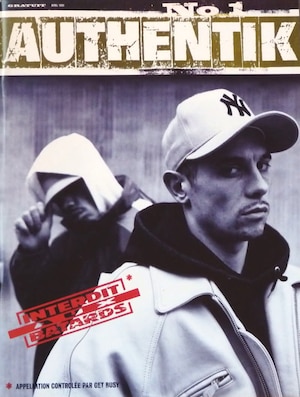
Authentik #1
In 1995, I stopped Get Busy. We’d taken the fanzine model to its logical conclusion, the rap press was emerging, backed by media empires, lots of ads, national distribution... We couldn’t compete. That had worn me down too.
In 1998, NTM’s management, AKA Seb Farran and Nicolas Nardone, along with Vrej Minassian from Sony, all wanted this magazine to accompany the release of NTM’s fourth LP. They were inspired by a magazine published by the Beastie Boys that covered all kinds of topics. And that in fact is what I liked about the project. That, and the fact that it was free. Hip hop had been around in France for 20 years, and for 20 years, French society had been trying to analyse it, so I thought it was high time that a hip hop magazine analysed French society instead. We published a first issue and I was editor-in-chief along with Yannick Bourg, a friend who was raised on rock music and detective novels. We were only supposed to bring out one of these, but it got such a great welcome that we ended up publishing three.
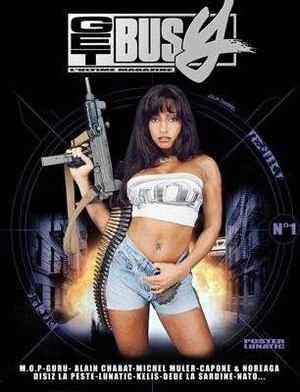
Get Busy Magazine #1
Unlike our “colleagues” in the rap press, we didn’t sell our covers out to majors. Actually, we wanted this concept so we would never have to argue about who was to appear on the front of the mag. Our reference point was the SAS [detective novel] book series. We really wanted a typical style and some kind of continuity. So that, at the end, when you had all the issues, you could make your own Pirelli calendar with all the different pics. it’s probably because we were raised on Pif Gadget [comic strip for kids, very popular in the ’70s and ’80s with a lot of collectibles].

Get Busy Magazine #5
All the rappers were highly critical of the rap press. For various reasons: its inner workings, its journalists with no street cred, its advertorials (which weren’t just common practice but almost a standard), and the virtual absence of negative criticism, especially if a major label was footing the bill.
But they couldn’t stand criticism. They liked it when others got roasted, but couldn’t take the heat. They took part in this school of journalism, funded it, gave them interviews. Some thought, for example, that they deserved to be on the cover because they’d placed an ad with us. But in the end, they only got the press they deserved.
I was never put under any pressure, personally, but if I could start over, I wouldn’t have made friends with any of the artists. You’re always the best as long as you agree with them, especially if you have a go at their rivals. But the day you no longer see eye to eye on something, you’re a traitor.
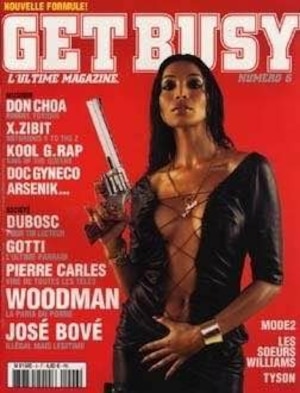
Get Busy Magazine #6
When all you do is interview rappers, you end up going round in circles. You’re always asking pretty much the same questions and getting the same answers, even if we did manage to gear them towards other topics of discussion, more focused on human nature than something purely artistic. After a while, I also wanted to learn something from Get Busy, to cover other subjects and other types of people like controversial lawyer Jacques Vergès, communist gangster Charlie Bauer and eco-activist José Bové.
We stayed true to our roots, even when we published Authentik. Hip hop had been part of the landscape in France for a while, and seen how it had influenced music in general, as well as fashion and advertising, and even how it had entered the political arena, albeit involuntarily, I thought that there was an obvious place for a magazine based on social issues that came from this culture, a bit like les Inrocks which became a cultural magazine though its roots are in indie pop.
I don’t know if rap journalism exists as such, but there was clearly a Get Busy tone, a certain spirit. Whether you agreed with the content or not, when you read the magazine, you felt that there were real people behind the articles, not just a bunch of typewriters, record company stooges or bored journalists just putting in the hours. We were never mere colleagues – we formed a genuine crew, with its ups and downs, its alliances and its drama.
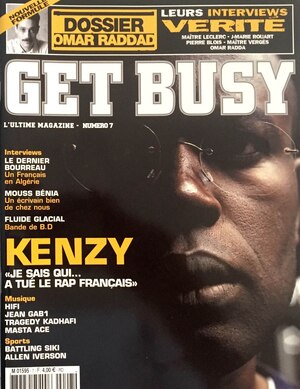
Get Busy Magazine #7
Get Busy stopped as it was no longer financially viable. Content is one thing; the financial aspect is another. I ended up having to manage both and I don’t think I had the strength to do that at the time. Especially when the people you work with are pretty much your mates, and not just hacks you pay. That puts you in a tricky moral position.
I’m not a money guy basically, I don’t like to lose but I don’t really know how to win. Even when it comes to sport, I’m more interested in the beauty of a certain performance than in victory. When I used to watch the tennis, I’d always root for McEnroe even when he was losing against Borg or Lendl, as I thought that his game had more class.
I think that maybe we turned up a bit too early with the content we were offering. We were pioneers and others came after us to reap the rewards. Generally speaking, it’s always those with the best strategy, but also the smoothest and the blandest, who end up raking it in. Those are the rules of the game, that’s the “revenge of the weak,” and you have to accept it.
In the end, I’ve nothing to complain about, I’m not rich but I’m not on skid row either, my fridge and wardrobe are full and more importantly, I got to do what I wanted. I travelled and met people whose music, whose films and whose work I loved. Get Busy, the fanzine, and even the magazine version, Authentik, both had a bit of “cult” status for some. It’s gratifying. And when you see where I come from, well part of the guys from my generation are still in prison or in the madhouse, or they’re set to go back, and others have ended up addicts, some are even dead. Hip hop gave me a way out from all of that. It allowed me to find myself and achieve my dreams, it turned me into the man I am. I’m one of the lucky ones.
